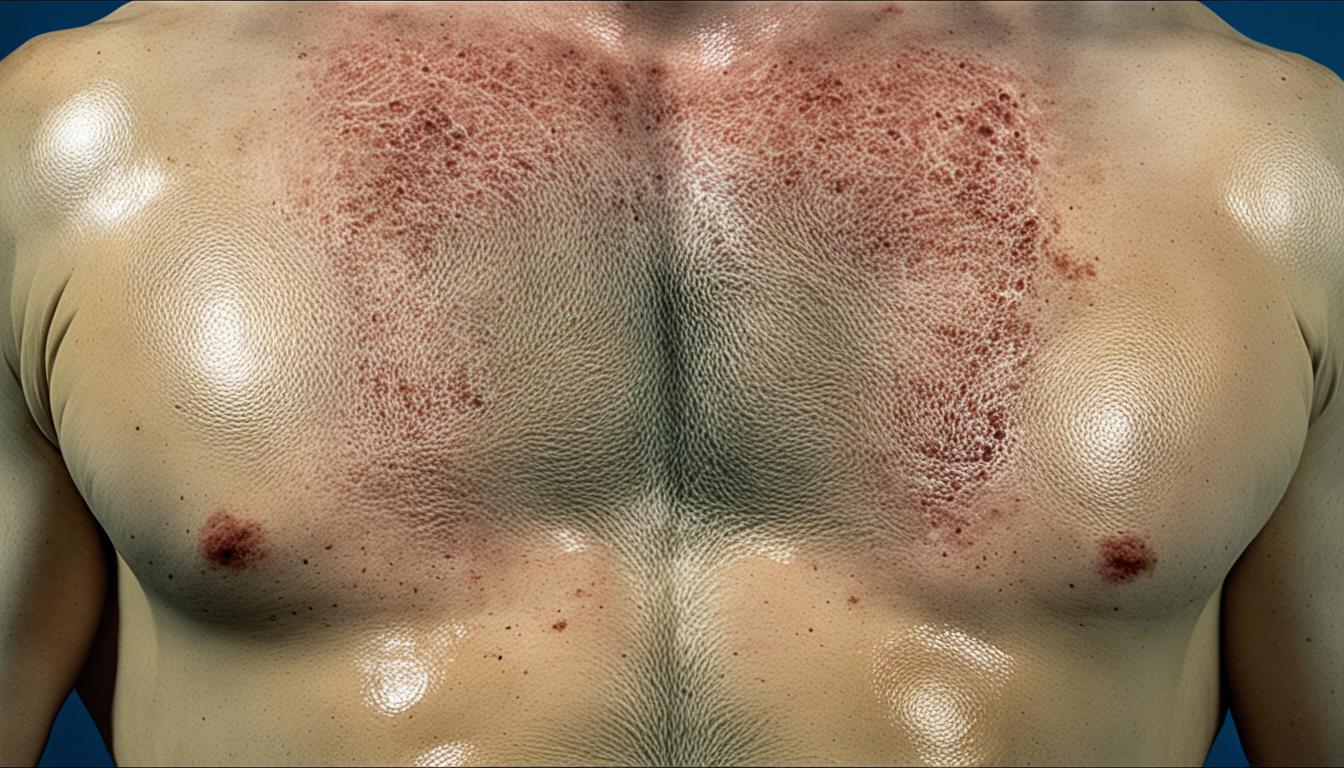Tinea versicolor is a common skin condition caused by a fungal infection. It leads to discolored patches of skin, often seen as pale spots on the upper back and shoulders. This condition is primarily caused by a yeast, Malassezia furfur. The yeast makes a substance that slows down the skin’s color-making process.
People of all ages can get tinea versicolor, but it’s more likely in teens and young adults. If you live in a hot, humid place or have oily skin, you’re at higher risk. This is because these factors help the fungus grow.
Key Takeaways:
- Tinea versicolor is a fungal infection that causes discolored patches of skin.
- It is characterized by pale spots on the upper back and shoulders.
- The main cause is a yeast called Malassezia furfur.
- Tinea versicolor is more common in adolescents and young adults.
- Hot and humid climates and increased sweating can contribute to its prevalence.
Symptoms of Tinea Versicolor
Tinea versicolor, AKA pityriasis versicolor, has unique symptoms. It shows as pink, brown, or white spots on your skin. These spots might be small at first, but they can get bigger and join up.
This will form into large, irregular patches. The skin in these areas is usually smooth and might have a fine scale. You can easily scratch this scale off.
The rash from Tinea versicolor is often seen on your back, chest, neck, and sometimes even your face. Though it usually doesn’t hurt, it can make you itch, especially if you’re sweaty. In places that are hot and humid, this condition can come back after going away. That’s why spotting the symptoms early is crucial.
Common symptoms of Tinea Versicolor:
- Appearance of pink, brown, or white spots on the skin
- Spots may grow in size and merge together, forming large patches
- Affected areas are usually smooth with a fine scale that can be scraped off
- Rash is typically found on the back, chest, neck, and sometimes the face
- Rash is generally painless but can become itchy when sweating
- Tinea versicolor can persist and recur, especially in hot and humid climates
If you know these symptoms, you can get help sooner for Tinea versicolor. It’s good to treat it as soon as possible.
| Tinea Versicolor Symptoms | Description |
|---|---|
| Discolored spots on the skin | Pink, brown, or white spots that may merge into large patches |
| Smooth skin | Affected areas are typically smooth with a fine scale |
| Rash location | Mainly found on the back, chest, neck, and occasionally the face |
| Painless but itchy | Rash is generally painless but can become itchy when exposed to sweat |
| Persistent and recurrent | Tinea versicolor can persist and recur, especially in hot and humid climates |
Causes and Diagnosis of Tinea Versicolor
Tinea versicolor happens when too much of the yeast Malassezia furfur grows on the skin. This growth is due to hormonal changes, more sweat, and sweat getting different. Knowing these causes helps in preventing and treating the issue.
Hormonal shifts can boost the yeast’s growth. This happens in puberty, pregnancy, or when using certain birth control methods. More sebum is produced, creating a good place for yeast to live.
Sweating more in hot, damp places also raises the risk of Tinea versicolor. The moist, warm environment from sweat is perfect for the yeast to grow.
The makeup of sweat can change, too, leading to Tinea versicolor. Some sweat parts, like fatty acids and amino acids, can feed the yeast. This helps it grow and cause infection.
Diagnosis of Tinea Versicolor
To diagnose Tinea versicolor, a doctor or nurse will look at your skin. They will check for colored patches and ask about your symptoms. Often, this is enough to guess the issue.
But for sure signs, they may do a skin scraping test. They take a tiny skin sample from the area and mix it with potassium hydroxide. Looking at it under a microscope can show the yeast.
Sometimes, a wood lamp might be used in diagnosing Tinea versicolor. This UV light makes the affected areas light up. It helps when the diagnosis isn’t clear or the problem isn’t obvious.
Treatment and Prevention of Tinea Versicolor
The treatment for Tinea versicolor often involves using special creams. These creams, like ketoconazole or clotrimazole, are designed to kill the infection on the skin. You should put the cream on the infected areas just like your doctor tells you to. Use the cream regularly for the full time your doctor says. This could be a few weeks up to several months.
If the infection is severe or doesn’t go away with creams, you might need pills. These pills fight the infection from inside your body. They might take longer to work. It’s very important to take the pills exactly as your doctor tells you.
Stopping Tinea versicolor from coming back means staying clean and dry. This stops the fungus from growing on your skin. Try not to sweat too much by wearing loose and cool clothes. Take showers often with mild soap. Using soap or shampoo that fights fungus can also help a lot.
If you treat and take steps to prevent Tinea versicolor, you can keep it under control. Always talk to a doctor for the best advice and treatment plan.

